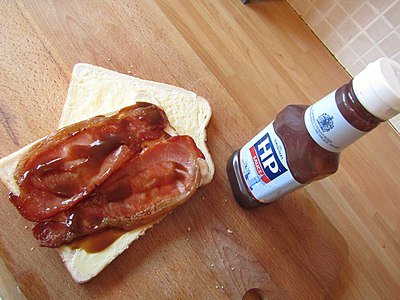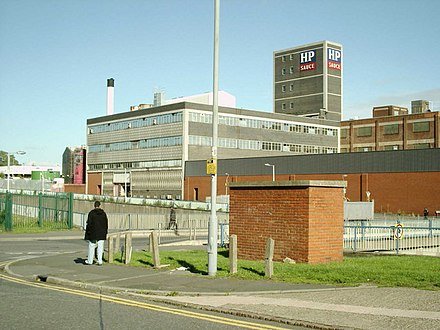British Heritage
Remember, Cherish, Learn.
beta
HP Sauce - A Full British isn't Breakfast Without It.
An Iconic Taste of British Heritage.
As the heart of traditional British cuisine, HP Sauce has transcended its original purpose as a condiment and has become a national symbol, beloved by the British public. From humble beginnings to international recognition, HP Sauce has steadfastly occupied a privileged position on Britain's dining tables and is an integral part of the country's gastronomic heritage.
First registered as a brand in 1895, HP Sauce was named after London's Houses of Parliament, a fact commemorated on the label with a charming illustration of London's famous landmarks, including Elizabeth Tower, the Palace of Westminster, and Westminster Bridge. This iconic brown sauce, with a base of tomatoes and tamarind extract, has been a staple of British cuisine since its introduction in the late 19th century.
Complemented with a blend of malt vinegar, spirit vinegar, sugars, dates, cornflour, rye flour, salt, and spices, HP Sauce offers a unique, tangy taste profile that enhances both hot and cold savoury dishes. Moreover, its rich flavour adds depth to soups and stews, marking it as a versatile addition to a myriad of recipes.
The origins of HP Sauce lie in the mid-19th century when David Hoe of Bottesford started crafting sauces to accompany locally made pork pies. The business evolved into David Hoe & Sons and Hoe Brothers, sauce manufacturers, enjoying patronage from the Prince of Wales. The recipe for what we now know as HP Sauce was later sold to Frederick Gibson Garton, a grocer from Nottingham, who officially registered the name H.P. Sauce in 1895.
In 1903, the recipe was passed on to Edwin Samson Moore, founder of the Midlands Vinegar Company, in exchange for £150 and the settlement of Garton's debts. Over the years, the image of the Houses of Parliament has remained a constant on the sauce's labels, tying the brand firmly to its British roots.
During the 1960s and 1970s, HP Sauce even enjoyed an informal association with British politics. It was popularly referred to as "Wilson's gravy" following an interview with the wife of Prime Minister Harold Wilson, where she revealed the leader's fondness for generously using HP Sauce.
The HP Sauce brand journeyed through several hands in the ensuing decades. After initially being owned by the Midlands Vinegar Company, it was passed onto Smedley HP Foods Limited, followed by a division of Imperial Tobacco. The French Groupe Danone SA bought it in 1988 for £199 million.
In June 2005, Heinz acquired HP Foods, and with it, the HP Sauce brand from Danone. The acquisition, initially referred to the Competition Commission by the United Kingdom Office of Fair Trading, was eventually approved in April 2006 for £440 million.
A significant shift in HP Sauce's history came in May 2006 when Heinz announced plans to move production from Aston, Birmingham to its European facility in Elst, Netherlands. The announcement spurred public outcry and led to a boycott call against Heinz products. Despite the backlash and job losses, Heinz proceeded with the relocation. Production at the Aston factory ceased in March 2007, and the factory was subsequently demolished.
Today, under the ownership of Heinz, HP Sauce continues to be produced in the Netherlands, maintaining its iconic recipe while adapting to contemporary production facilities. The sauce is now distributed globally, retaining its position as the best-selling brown sauce in the UK and introducing international audiences to the taste of British tradition.
HP Sauce is available in various formats and sizes to cater to diverse consumer preferences. The classic 9 oz/255 g glass bottle continues to be a favourite, with the addition of plastic squeeze bottles and TopDown bottles for convenience. Furthermore, over the years, different markets have seen variations in the HP Sauce recipe. For instance, the versions produced for the Mexican and Canadian markets in 2007 were lighter and less concentrated, illustrating the brand's adaptability to regional tastes.
HP Sauce has, over the years, become more than just a popular condiment. Its unique flavour and historical roots have ingrained it deeply into British culture, making it a culinary tradition passed down generations. From David Hoe's initial recipes to Heinz's global distribution, the journey of HP Sauce is a testament to the lasting appeal of quality and tradition. It stands as a symbol of British heritage, a flavourful thread that ties together British history, culture, and gastronomy.
Overview and Unique Flavour Profile
First registered as a brand in 1895, HP Sauce was named after London's Houses of Parliament, a fact commemorated on the label with a charming illustration of London's famous landmarks, including Elizabeth Tower, the Palace of Westminster, and Westminster Bridge. This iconic brown sauce, with a base of tomatoes and tamarind extract, has been a staple of British cuisine since its introduction in the late 19th century.
Complemented with a blend of malt vinegar, spirit vinegar, sugars, dates, cornflour, rye flour, salt, and spices, HP Sauce offers a unique, tangy taste profile that enhances both hot and cold savoury dishes. Moreover, its rich flavour adds depth to soups and stews, marking it as a versatile addition to a myriad of recipes.
Historical Journey
The origins of HP Sauce lie in the mid-19th century when David Hoe of Bottesford started crafting sauces to accompany locally made pork pies. The business evolved into David Hoe & Sons and Hoe Brothers, sauce manufacturers, enjoying patronage from the Prince of Wales. The recipe for what we now know as HP Sauce was later sold to Frederick Gibson Garton, a grocer from Nottingham, who officially registered the name H.P. Sauce in 1895.
In 1903, the recipe was passed on to Edwin Samson Moore, founder of the Midlands Vinegar Company, in exchange for £150 and the settlement of Garton's debts. Over the years, the image of the Houses of Parliament has remained a constant on the sauce's labels, tying the brand firmly to its British roots.
During the 1960s and 1970s, HP Sauce even enjoyed an informal association with British politics. It was popularly referred to as "Wilson's gravy" following an interview with the wife of Prime Minister Harold Wilson, where she revealed the leader's fondness for generously using HP Sauce.
Ownership Changes and International Spread
The HP Sauce brand journeyed through several hands in the ensuing decades. After initially being owned by the Midlands Vinegar Company, it was passed onto Smedley HP Foods Limited, followed by a division of Imperial Tobacco. The French Groupe Danone SA bought it in 1988 for £199 million.
In June 2005, Heinz acquired HP Foods, and with it, the HP Sauce brand from Danone. The acquisition, initially referred to the Competition Commission by the United Kingdom Office of Fair Trading, was eventually approved in April 2006 for £440 million.
A significant shift in HP Sauce's history came in May 2006 when Heinz announced plans to move production from Aston, Birmingham to its European facility in Elst, Netherlands. The announcement spurred public outcry and led to a boycott call against Heinz products. Despite the backlash and job losses, Heinz proceeded with the relocation. Production at the Aston factory ceased in March 2007, and the factory was subsequently demolished.
Today, under the ownership of Heinz, HP Sauce continues to be produced in the Netherlands, maintaining its iconic recipe while adapting to contemporary production facilities. The sauce is now distributed globally, retaining its position as the best-selling brown sauce in the UK and introducing international audiences to the taste of British tradition.
Varieties and Packaging
HP Sauce is available in various formats and sizes to cater to diverse consumer preferences. The classic 9 oz/255 g glass bottle continues to be a favourite, with the addition of plastic squeeze bottles and TopDown bottles for convenience. Furthermore, over the years, different markets have seen variations in the HP Sauce recipe. For instance, the versions produced for the Mexican and Canadian markets in 2007 were lighter and less concentrated, illustrating the brand's adaptability to regional tastes.
Conclusion
HP Sauce has, over the years, become more than just a popular condiment. Its unique flavour and historical roots have ingrained it deeply into British culture, making it a culinary tradition passed down generations. From David Hoe's initial recipes to Heinz's global distribution, the journey of HP Sauce is a testament to the lasting appeal of quality and tradition. It stands as a symbol of British heritage, a flavourful thread that ties together British history, culture, and gastronomy.
- HP Sauceen.wikipedia.org










